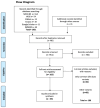A Systematic Review and Meta-Analysis on the Prevalence of Variants in the Pancreaticobiliary Duct Junction and Its Association with Cancer
- PMID: 40426867
- PMCID: PMC12109207
- DOI: 10.3390/biomedicines13051039
A Systematic Review and Meta-Analysis on the Prevalence of Variants in the Pancreaticobiliary Duct Junction and Its Association with Cancer
Abstract
Background/Objectives: The objective of this study was to describe the anatomical variants of the pancreaticobiliary junction and how its position or structural change could be associated with hepatic, duodenal, and pancreatic clinical complications. Methods: We searched MEDLINE, Scopus, Web of Science (WOS), Google Scholar, CINAHL, and EMBASE databases from their inception up to September 2024. Results: Two authors independently performed the search, study selection, data extraction, and assessed the methodological quality with an assurance tool for anatomical studies (AQUA). Finally, the pooled prevalence was estimated using a random effects model. A total of 59 studies with a total of 22,752 participants were included in this review. The overall prevalence of the anomalous pancreaticobiliary junction (APBJ) variant was 12% (95% CI = 6% to 18%). The prevalence of cancer associated with variants of APBJ was 29% (95% CI = 23% to 34%). Conclusions: In the present anatomical systematic review and meta-analysis, we found that a longer common channel correlated with a higher prevalence of bile duct or gallbladder malignancy, due to the backward flow of bile which occurs as a result of the position and distance of the bile ducts, as well as pancreatic failing. Hence, APBJs are of great interest for gastroduodenal surgeons.
Keywords: cancer; pancreaticobiliary junction (PBJ); pancreaticobiliary junction cancer; pancreaticobiliary maljunction.
Conflict of interest statement
The authors declare no conflicts of interest.
Figures









References
Publication types
LinkOut - more resources
Full Text Sources

